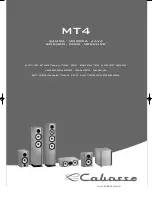
For optimum sound, the use of high-quality speaker cable is essential. The chart
to the right identifies the minimum gauge requirements for various lengths.
(See dealer for more information.)
Your Paradigm
®
Special Edition speakers’ binding posts can be used with
banana, pin or spade connectors, as well as with bare wire. Tighten the posts
firmly by hand—do not over tighten!
Correct polarity (or phase) is critical for proper soundstage imaging and bass
performance. Connect one speaker at a time to ensure proper connection of
every channel. The red (+) amplifier terminal must be connected to the red (+)
speaker terminal. The same applies to the black (–) terminals. Make sure
all wires are firmly fastened. Repeat this connection procedure for each
speaker in your system.
NOTE:
If you hear a distinct lack of bass and a dislocated stereo image then
one or more of your speakers may have been connected out of phase (their
polarity is reversed). Re-check to ensure that each speakers’ cable is con-
nected with correct polarity: red (+) to red (+) and black (–) to black (–).
SPEAKER CONNECTION
CONNECTION FOR PARADIGM
®
SPECIAL EDITION (SE 1)
BOOKSHELF MODEL AND CENTER CHANNEL (Fig. 8)
Your Paradigm
®
Special Edition (SE 3) floorstanding speakers have two sets
of input terminals connected externally with jumper bars. The speaker can
be bi-wired or bi-amplified to achieve even better performance.
Standard Connection (Fig. 9)
For standard connection, leave the jumper bars attached and connect using
either set of input terminals.
Bi-wire Connection (Fig. 10)
Bi-wiring can improve clarity and openness, with less grain and more solidity
to the bass. Two cables are required for each speaker that you bi-wire.
Bi-amp Connection
IMPORTANT!
When bi-amping, always use amplifiers with identical gain.
If uniform amplifier gain is not maintained the speaker-to-speaker balance
will be incorrect when vertically bi-amped, or the speaker system’s frequency
balance will be incorrect when horizontally bi-amped. To prevent problems,
use identical amplifiers (Brand and Model). Make sure they are operating
in the same non-bridged or bridged mode.
Passive bi-amping offers a dramatic improvement in clarity, openness and
detail, with much better bass solidity and definition. The presentation of music
and movie soundtracks is simply more intelligible and transparent.
With passive bi-amping, the speaker’s internal passive crossovers remain
connected. An external electronic crossover is not required and cannot be
used (there is no direct electrical access to individual drive units). This saves
expense and setup difficulties. Passive bi-amping optimizes your speaker
to achieve the best possible high-end performance.
To bi-amplify, two power amplifiers are required. Connection can be either
vertical or horizontal.
Horizontal Bi-amplification (Fig. 11)
dedicates one amplifier to
your speakers' mid/low-frequency inputs and another to their high-frequency
inputs. This configuration can maintain better clarity when listening at
loud levels—if low-frequency demands cause amplifier clipping, distortion
will still be kept away from high-frequency drivers. Connect your speakers
to one amplifier at a time.
Vertical Bi-amplification
(not shown) dedicates one amplifier to
each speaker. This configuration provides complete channel separation which
optimizes your system’s imaging ability. Connect your speakers to one
amplifier at a time.
LENGTH
DIAMETER
GAUGE
Under 4.5 m (15 feet)
1.3 mm (0.05 in)
16 awg
Under 9 m (30 feet)
1.6 mm (0.06 in)
14 awg
Over 9 m (30 feet)
2.0 mm (0.08 in)
12 awg
MINIMUM GAUGE REQUIREMENTS
13
CONNECTION OPTIONS FOR THE PARADIGM
®
SPECIAL
EDITION (SE 3) FLOORSTANDING MODEL
Turn your amplifier(s) OFF before connecting your
speakers. This will avoid damage which could result
from accidental shorting of speaker cables.
DO NOT attempt to bi-wire or bi-amplify unless you
have removed the jumper bars.
Summary of Contents for SE series
Page 1: ...OWNERS MANUAL PARADIGM ELECTRONICS INC MAN0001004 111109 w w w p a r a d i g m c o m...
Page 10: ...SUB IN LFE IN Fig 15 SUBWOOFER CONNECTION SUBWOOFER PLACEMENT Fig 14 9 Fig 13a Fig 13b Fig 13c...
Page 22: ...NOTES...
Page 23: ...MODE D EMPLOI MD PARADIGM ELECTRONICS INC MAN0001004 111109 w w w p a r a d i g m c o m...
Page 44: ...REMARQUES...















































